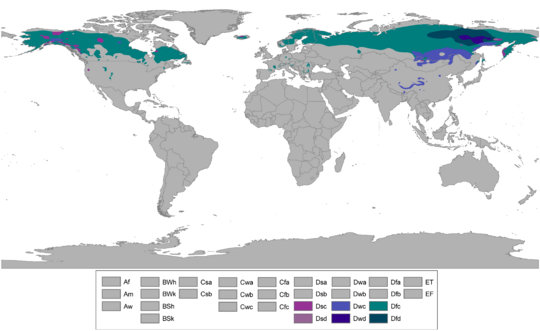Subarctic climate facts for kids
A subarctic climate (also called a boreal climate) is a type of weather found in places with very long, cold winters and short, warm summers. You can find this climate on large land areas, far from the oceans. It is usually located between 50° and 70°N latitude (how far north or south a place is).
Since there are no big land areas in the Southern Hemisphere at these latitudes, this climate is mostly found in the Northern Hemisphere. In the Southern Hemisphere, it only appears in high mountains like the Andes or the mountains of Australia and New Zealand's South Island. Climate scientists group these areas as Dfc, Dwc, Dfd, and Dwd in the Köppen climate classification system.
Template:TOC limit=3
Contents
Temperatures and Seasons
Places with a subarctic climate have huge changes in temperature throughout the year. Winters are extremely cold. Temperatures can drop to -40 °C (which is also -40 °F).
Summers are short but can be warm. Temperatures might even go above 30 °C (86 °F). However, there are usually no more than three months where the average temperature is at least 10 °C (50 °F). At least one month must have an average temperature of 10 °C (50 °F) or higher. Also, the coldest month of the year must be below 0 °C (32 °F).
The subarctic climate is found between the humid continental climate and the polar climate. Summer is very short, lasting about 45 to 100 days at most. In many subarctic places, temperatures can drop below freezing (0 °C or 32 °F) at any time of the year, even during summer.
Where to Find Subarctic Climates
You can find subarctic climates in these areas:
- Most of Siberia in Russia
- The northern part of Scandinavia (though coastal areas have milder winters)
- Most of Alaska in the USA
- A large part of Canada, from about 50°N up to the tree line. This includes:
- Southern Labrador
- Northern Quebec (but not the very far north)
- Far northern Ontario
- The northern Prairie Provinces
- Most of the Yukon
- Most of the Northwest Territories
Permafrost and Soil
In subarctic climates, the average temperature stays below freezing for 5 to 7 months in a row. This means that all the water in the soil freezes several feet deep. In the coldest parts of this climate, the summer warmth is not enough to thaw (unfreeze) more than a few feet of the topsoil. This leads to permafrost, which is soil that stays frozen all the time.
When the ice melts in the summer, about 0.6 to 4 meters (2 to 14 feet) of soil can thaw. How much thaws depends on how far north the place is and what type of soil it has. Some subarctic areas near oceans, like southern Alaska and the northern edge of Europe, have milder winters. They do not have permafrost, which makes it a bit easier to farm there.
Plants and Forests
The vegetation (plants) in a subarctic climate usually has low biodiversity (meaning only a few different types of plants grow). This is because only hardy (very tough) species can survive the long, cold winters and make the most of the short summers.
Most of the trees are evergreen conifers. These are trees that have needles and cones, like pine or spruce. Few broadleaved (trees with wide, flat leaves) trees can survive the very low winter temperatures. This type of forest is known as the taiga. The word taiga can also refer to the climate itself.
Even though there are only a few different kinds of plants, a lot of plants grow in the taiga. The taiga (or boreal) forest is the largest forest biome on Earth. Most of these forests are found in Russia and Canada.
Farming and Precipitation
It is usually very hard to farm in subarctic climates. The soil is often infertile (it does not have many nutrients that plants need to grow). Also, there are many swamps and lakes left behind by ancient ice sheets. Only very tough crops can survive the short growing seasons.
On the bright side, days are much longer in the summer as you get closer to the poles. This means that the plants that can grow get a lot of sunlight. Crops like potatoes, strawberries, blueberries, and hay for animals grow well. Special types of other plants can also be grown.
There is very little precipitation (rain, snow, sleet, or hail) in subarctic climates. Usually, no more than 38 to 50 centimeters (15 to 20 inches) falls over an entire year. Rain and snow may stay on top of the ground until the ground melts. This means that when the precipitation finally soaks into the ground, it can become very wet and muddy.
Transition to Tundra
As you get closer to the Earth's poles and the water around them, the warmest month has an average temperature of less than 10 °C (50 °F). When this happens, the subarctic climate changes into a tundra climate. The tundra climate is even harsher for trees, and they usually cannot grow there.
Places with Subarctic Climates
Here are some cities and towns that have a subarctic climate:
- Fairbanks, Alaska
- Whitehorse, Yukon
- Yellowknife, Northwest Territories
- Thompson, Manitoba
- Moosonee, Ontario
- Goose Bay, Newfoundland and Labrador
- Rovaniemi, Finland
- Kiruna, Sweden
- Arkhangelsk, Russia
- Irkutsk, Russia
- Chita, Russia
Some places in the Dfd climate group, which is a very, very cold subarctic climate, include:
- Oymyakon, Russia
- Verkhoyansk, Russia
Images for kids
-
View of pines in the Kuysumy mountains in Siberia
See also
 In Spanish: Clima subpolar para niños
In Spanish: Clima subpolar para niños




